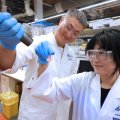Magnetic resonance imaging invention earns big dollars
An invention by University of Queensland researchers which improves magnetic resonance imaging is earning about $1 million a year for the University.
Magnetic resonance imaging is a non-invasive way using nuclear magnetic resonance of protons to produce images of the human body.
Royalties have totalled more than $2.5 million since the invention was patented in 1994.
The technology was developed by the University's Centre for Magnetic Resonance by a team led by the Centre's Director, Professor David Doddrell, and Dr Stuart Crozier.
Professor Doddrell said the patent could be worth more than $20 million to the University over the life of the agreements.
He said the technology made it possible to control eddy currents in large magnets, resulting in clearer magnetic resonance images.
"This significantly improved performance enhances the usefulness of high-speed imaging techniques in many diagnoses of human ailments," Professor Doddrell said.
University of Queensland technology transfer company UniQuest Limited has licence agreements with medical imaging and telecommunications company Siemens AG in Erlangen, Germany, and General Electric (GE) in Milwaukee to use technology developed by the University's Centre for Magnetic Resonance.
Professor Doddrell said Siemens and GE were the major international players in the field of manufacturing and marketing magnetic resonance equipment for medical diagnosis.
"Each of these magnetic resonance imaging systems sells in the range of $1 million to $2 million, so it makes sense for manufacturers to gain every extra bit of clarity to advance sales."
The Centre also manufactures and sells equipment for magnetic resonance.
"We have also made sales and orders amounting to $3 million for a range of six or seven NMR product types, such as advanced probes for analysing various types of tissues," Professor Doddrell said.
"Orders and sales in 1998 peaked at $1.2 million and so far this year are running at $520,000 so the level of interest appears to be increasing."
The Centre's workshop of 10 technical staff has directly contributed to the development of the new products.
The research embraces the development of equipment and techniques, and applying new technology to diagnosing and examining diseases in humans and animals.
For further information, contact Professor David Doddrell, telephone 3365 4100.
.jpg)


